Drunken Karst-21-day tour of Zhangjiajie, Fanjing Mountain, Libo, Huangguoshu, and Puzhei
The initial plan for travel in September this year was Fanjing Mountain, Huangguoshu and Libo in Guizhou, and then went to Puzhehei in Yunnan to visit old friends. Later, when looking for routes, I found that Zhangjiajie in Hunan was not far from Fanjing Mountain. I finally decided to go to Zhangjiajie first and then to Guizhou.
The total cost (2 people) is 17,949.25 yuan, including: transportation 5,006.00 yuan, accommodation 4,414.15 yuan, tickets (including scenic sightseeing buses, cableways, etc.) 3,271.60 yuan, shopping, meals, city fares and miscellaneous expenses 5,257.50 yuan.
D1
Our plane landed at Zhangjiajie Hehua Airport on time at 10:35. We took a bus from the airport to Zhangjiajie Bus Station, and then transferred to a minibus from Zhangjiajie City to Wulingyuan. We arrived at Wulingyuan Bus Station 50 minutes later. After dropping our luggage at the inn, we arrived at the Wulingyuan Sign Gate Ticket Station in Wulingyuan Scenic Area.
Wulingyuan Scenic Area is located in the northwest of Hunan Province. It has the world's rare quartz sandstone peak forest canyon landform. It consists of China's first national forest park-Zhangjiajie National Forest Park and Tianzishan Nature Reserve, Suoxiyu Nature Reserve, and Yangjiajie. It consists of four major scenic spots. It is full of exotic flowers and grasses, green pines and cypresses cover the sky; strange peaks and rocks stand out; streams surround clouds and valleys, and smoke grows on the cliffs.
There are 5 entrances to the scenic area. Entering the scenic area from the Wulingyuan Sign Gate Ticket Station and the Forest Park Ticket Station is the first choice for most tourists.
Since there was only half a day today, our first stop was the Shili Gallery Scenic Area in Wulingyuan Scenic Area. Tickets for the scenic spot are booked online and exchanged for magnetic card tickets with ID cards at the Wulingyuan Sign Gate Ticket Station, which is valid for four days. Fingerprint information is required to enter the scenic spot for the first time, and you can enter the scenic spot unlimited times from each ticket station within four days. After entering the scenic area from the Sign Gate Ticket Station, take the scenic sightseeing bus directly to the Shili Gallery Scenic Area.
The Zhangjiajie Shili Gallery Scenic Area is about five kilometers long and has rich natural landscapes. Walking while you are walking is like a painting. Dai Peak stands next to the ditch. The rocks on the mountain form more than 200 stone scenery shapes that resemble people, objects, birds and beasts. Among them, the "Old Herb Picking Man" and the "Three Sisters" are the most famous.
Entering the scenic spot, you will find lush forests on both sides and fragrant wild flowers; strange peaks and strange stones in various shapes, like huge mountain and water scrolls hanging side by side on the cliffs of thousands of feet, allowing the peerless natural wonders to be integrated into the ink paintings of the immortal master painters. But next to the pedestrian path is the track of a small train. Small trains pass by from time to time, and the noise generated breaks the tranquility here.
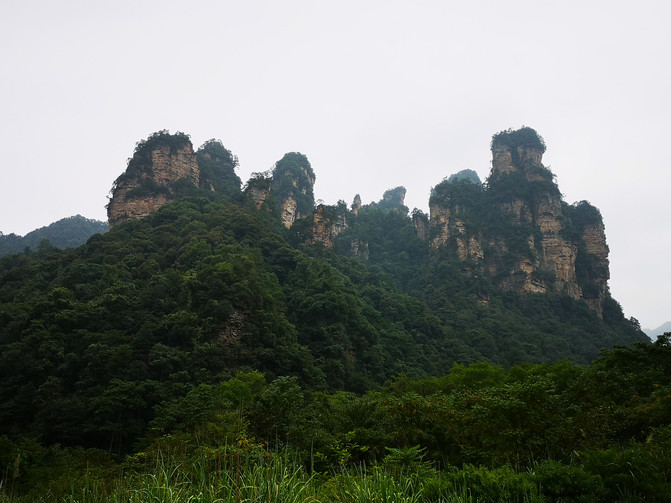
Shili Gallery--Tengou Watching the Sun

Shili Gallery-Index Finger Peak

Shili Gallery--Old Man Picking Medicine

Shili Gallery-Three Sisters
After returning from Shili Gallery, I wanted to go to Xibu Street for a walk, but the taxi driver said that Xibu Street was only lively at night, so I decided to go back to the inn to rest first and go to Xibu Street later.
The inn is not far from Xibu Street. At 6 o'clock in the evening, we walked from the inn to Xibu Street.
Xibu Street is located in Wulingyuan District, Zhangjiajie. It is the only complex tourist and commercial pedestrian street in the country that integrates water bar street, Chinese famous snack street, Xiangxi folk shopping street, leisure inn, creative workshop, etc.
But when I arrived there, I found that most of the shops were not open, only a few shops were open, and the streets were deserted. After shopping around, I found it boring. On the way back, I tasted the famous Sanxia Pot in Zhangjiajie at Master Hu Sanxia Pot. The quantity was large and the taste was good.

Wulingyuan Town-Xibu Street

Wulingyuan Town-Sanxiaguo
D2
Inns and bus stations in Zhangjiajie both have luggage check-in services, which can be checked to the mountains or down the mountain to facilitate tourists to travel and play. In the morning, I entrust the inn to check my luggage to the inn on the mountain. It takes about 40 minutes to drive from Wulingyuan Bus Station to reach the Forest Park Ticket Station parking lot. It takes about 10 minutes to walk from the parking lot to reach the entrance of the Forest Park Ticket Station.
Wulingyuan Scenic Area is divided into two parts: a scenic spot on the mountain and a scenic spot on the foot. The main parts at the foot of the mountain are Jinbian River, Shuizao Simen and Shili Galleries. The main parts on the mountain are Yuanjiajie Scenic Area, Yangjiajie Scenic Area, Tianzi Mountain Scenic Area and Huangshizhai Scenic Area. Among them, Yuanjiajie Scenic Area, Yangjiajie Scenic Area and Tianzi Mountain Scenic Area have scenic sightseeing buses interconnected, and Huangshizhai Scenic Area needs to take a cable car or walk up and down. We finished touring the Shili Gallery yesterday. Today we are going to visit the Huangshizhai Scenic Area on the mountain and the Jinbian River at the foot of the mountain.
Enter the scenic spot from the Forest Park Ticket Station and walk more than 10 minutes to the Dayang Bar Square. It takes only a few minutes to take a sightseeing bus to get to the Huangshizhai Cableway Station. Take the cable car to the Cableway Station to start a tour of Huangshizhai.
Huangshi Village is also known as Huangshi Village. It is supported by many cliffs and cliffs to form a terrace with high south and low north. It is the place with the most concentrated beautiful scenery in Zhangjiajie. It is also the largest aerial viewing platform in Zhangjiajie. There has always been a saying that "if you don't climb Huangshi Village, you will go to Zhangjiajie in vain."
The tour route of Huangshizhai is a loop line. When you exit the cableway, you stand up and walk along the walking path, you can see different forms of stone pillars, which are lifelike. At Five Finger Peak, towering stone pillars point to the sky with five fingers; natural murals are like a beautiful picture scroll displayed in front of your eyes; fairies lay flowers, and the stone pillars resembling fairies and surrounding vegetation are like fairies in the sky offering beautiful flowers to the world.

Huangshizhai Scenic Area

Huangshizhai Scenic Area

Huangshizhai Scenic Area

Huangshizhai Scenic Area

Huangshizhai Scenic Area
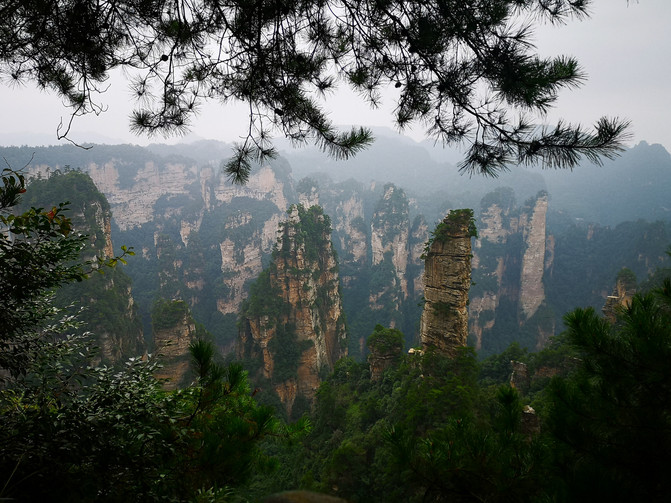
Huangshizhai Scenic Area
It was already noon after getting off from Huangshi Village and taking a bus back to Dayang Bar Square. You can enter Jinbian Creek from the walking path next to the Big Oxygen Bar Square.
The Jinbianxi River is 7.5 kilometers long and is named after it passes through one of the "Top Ten Outstanding Scenarios in Zhangjiajie"-the Jinbianyan where the Shenying Whip is protected. Walking through the peaks and valleys, the stream is clear and full of ups and downs, with small fish swimming in it; the flowers and plants along the stream are beautiful, birds sing and warblers sing, and people walking along the clear stream is better than swimming in a painting. It is known as "one of the most beautiful canyons in the world."
Starting from Dayang Bar Square and walking along the Jinbian River, you can see scenery such as the Shenying Whip Protection, Jinbian Rock, cutting mountains to save mothers, and meeting thousands of miles away. From time to time, wild monkeys appear. Most of the monkeys play and play in the woods or streams. Some daring monkeys ask tourists who pass by for food.

Golden Whip Creek-Shenying Whip Protection

Jinbianxi--The location where "Journey to the West" was filmed

Jinbian River-Changshou Spring

Jinbian River-Meeting thousands of miles
Jinbian River has a total length of 7.5 kilometers and its exit is at Shuihuan Simen. You can take a bus from Shuilaosimen to the Hundred Dragons Ladder, and then take the elevator to Yuanjiajie Scenic Area.
The Bailong Ladder has a vertical height difference of 335 meters and a running height of 326 meters. It consists of a 154-meter-long shaft in the mountain and a 172-meter-high steel structure derrick attached to the mountain. It uses three double-layer fully exposed sightseeing stands in parallel and runs in separate units. It is recorded in the Guinness World Record with the three titles of "the world's tallest fully exposed outdoor sightseeing elevator, the world's tallest double-layer sightseeing elevator, and the world's largest payload and fastest sightseeing elevator". It is a perfect combination of natural beauty and man-made wonders.
It was nearly 5 o'clock when we arrived at Shuiwasimen. After confirming that we had booked accommodation on the mountain, the sightseeing bus driver took us to the next station of Bailong Tianti. At this time, most tourists had already gone down the mountain. Not many people took the elevator up the mountain and there was no queue. It was said that when there were many people, they had to wait in line for several hours. It only takes more than 1 minute to take the elevator to reach the mountain. The elevator starts to run in the mountain. The moment the elevator rushed out of the mountain, it suddenly became clear in front of you. What appeared in front of you was an open and tidy stone forest.
We originally planned to visit Yuanjiajie Scenic Area first after going up the mountain. However, due to the heavy physical consumption of visiting Huangshi Village and Jinbianxi today, we decided to go back to the inn to rest first and play again tomorrow. The mountain is being demolished now, and there are not many inns. The inn we booked is in Laowuchang. When we came out of Bailong Tiantian, we took a bus directly to Sanchakou Station, and then contacted the innkeeper to pick us up back to the inn.
D3
After breakfast in the morning, the innkeeper took us to Sanchakou Station and took the bus to Yangjiajie Scenic Area first.
Yangjiajie Scenic Area is one of the four core tourist attractions in Zhangjiajie. Many of them are related to Yangjiajiang, including place names such as "Liulang Bay","Qilang Bay","Zongbao Bay" and "Tianbo Mansion". The scenic area has crisscross ravines, clear streams, and dense vegetation. It has unique peaks and dangerous cliffs, as well as streams and waterfalls with rolling jade, including Wulong Village, Tianbo Mansion, One Step to the Sky, and Air Corridor. Attractions.
We got off the bus at Wulongzhai, and then walked along the road for about ten minutes. There was a fork in the road. On the right were Wulongzhai and Tianbo Prefecture, and on the left were One-Step Sky and the Sky Corridor. We went to Wulongzhai and Tianbo Prefecture.
Wulong Village, formerly known as "Black Dragon Village", was a stronghold of bandits from the late Qing Dynasty and the Republic of China. After passing through a relatively gentle staircase, you reach the gate of Wulong Village. The first Ghost Gate from the stockade gate is "difficult to walk in one step". The path turns sharply to the right, and a rock protrudes abruptly. People must cling to the rock wall and turn slowly. If they are not careful, they will fall into the cliff. Continue to move forward, drilling holes and rocks, like a road but not a road. It is difficult to see people from a few meters away. The road of more than a hundred meters is difficult and tortuous. People need to bend down to get up. The second ghost gate,"who can not bow your head", blocks the road here. "Yifu Pass" is the third ghost gate of Wulong Village. The steep slope of nearly 100 meters is almost upright. The stone road passes between two huge rocks. People have to move sideways to slowly move up. It is really "one man is in charge of the pass, and ten thousand people cannot open it." It is not for a false reputation that Wulong Village has been established for many years.
After dozens of meters of relatively gentle stone path, there is another slope, and a mountain village stands high. There are broken walls and deep cliffs on all sides behind the stockade. Not far away, there is a lonely rock standing tall in the mountains. This is the strange sight hidden in the boudoir-Tianbo Mansion.
From the top of Tianbo Prefecture, you can have a wide view of all kinds of scenery. But to reach Tianbo Prefecture, you have to pass through a steep staircase with several small viewing platforms in the middle. Finally, you have to pass through two nearly vertical artificial iron ladders to reach the viewing platform of Tianbo Prefecture. We didn't go down. We just watched the scenery of Xiatianpo Prefecture through the gaps in the trees on the small viewing platform. We saw more than 10 stone walls standing relatively parallel, uneven heights, orderly arrangements, and very imposing. Presumably, if you watch from the viewing platform of Tianbo Prefecture, you will have a wider view and the momentum will be even more magnificent.

Yangjiajie Scenic Area-Wulong Village

Yangjiajie Scenic Area-Wulong Village

Yangjiajie Scenic Area-Tianbo Prefecture

Yangjiajie Scenic Area-Tianbo Prefecture
After getting down from Wulong Village and returning to the fork in the road, it is said that it takes three to four hours to walk back and forth to the Sky Corridor. In order to save our strength, we didn't go, but took a bus directly to Yuanjiajie Scenic Area.
Yuanjiajie is located in the north of Zhangjiajie National Forest Park, backed by the mountains and mountains, facing the valley peaks, extending from east to west. It is a scenic spot in Zhangjiajie Park and a pearl inlaid in the core scenic area of Wulingyuan. The main attractions include the Back Garden, Chizhuo Terrace, the First Bridge in the World, etc.
Get off at Tianxia First Bridge Station and follow the path to Weizhuo Terrace.
Looking around left and right on the viewing platform, you can have a panoramic view of thousands of scenes. The mountain peaks and stone pillars are like buildings and pavilions, like platforms and pavilions, with thousands of shapes and scenes. The cliffs of the secluded valley, the mysterious roses, and the beauty is beyond words.

Yuanjiajie Scenic Area--Chizhuo Terrace
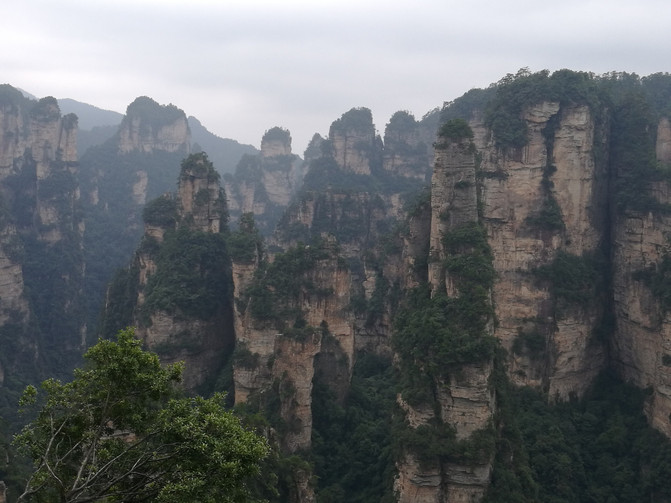
Yuanjiajie Scenic Area--Chizhuo Terrace

Yuanjiajie Scenic Area--Chizhuo Terrace

Yuanjiajie Scenic Area--Chizhuo Terrace

Yuanjiajie Scenic Area--Chizhuo Terrace
Yuanjiajie Scenic Area is a must-see place for tour groups. There are many people. We stayed on the viewing platform for a while and followed the trail towards the No. 1 Bridge in the world. You can see the famous "Nantian Pillar" in the middle.
"Nantian Yizhu" is one of the "Three Thousand Extraordinary Peaks" in Zhangjiajie. It has an altitude of 1074 meters and a vertical height of about 150 meters. The vegetation on the top is lush, the peak body is unique in shape, and the vertical joints are cut clearly, like a knife slicing an axe. Standing tall in Zhangjiajie, it has the potential to stand against the sky, so it is also known as the Qiankun Pillar. In December 2008, the picture of "Nantian Pillar" became the prototype of "Hallelujah Mountain", or suspended mountain, in the American science fiction blockbuster "Avatar", Zhangjiajie's "Nantian Pillar"(also known as Qiankun Pillar) was officially renamed "Hallelujah Mountain".

Yuanjiajie Scenic Area-"Hallelujah Mountain"
Moving forward is the "No. 1 Bridge in the World", a naturally formed stone bridge between two mountains. It is one of the "Top Ten Wonders" in Zhangjiajie and a landmark attraction in Yuanjiajie. The two mountains were originally one, and the bridge body is the key part connecting the two mountains. However, because the stone in the middle is relatively weak, due to the influence of weathering and collapse, and after being exposed to sun and rain, washing by running water, and the impact of mountain torrents, over time, it finally formed today. This special spectacle...
The pine trees are tall and straight on the bridge, and the clouds and mist ripple under the bridge, creating an abyss. Water droplets splashed on the cliffs around them. Stepping on the bridge makes people feel like they are flying in the sky. Holding the iron railing and looking up, you will see the green peaks ethereal among the clouds and mist; looking down, you will see the strange peaks like bamboo shoots, and the mist rises in the rocky ravines and deep valleys, scattering and gathering again.
The railing of the trail leading to the bridge is tied with many red ribbons for blessing, forming a spectacular scenery when viewed from afar.

Yuanjiajie Scenic Area-"The First Bridge in the World"

Yuanjiajie Scenic Area-"The First Bridge in the World"
Coming out of the First Bridge in the World, we took a bus and got off at Daguan Tai Station. There was a gas station along the road. Because tour groups did not come here, there were no people. At first, I thought I had taken the wrong way, but I happened to meet a fellow villager. When I asked, I learned that if I continued on, I would be Daguan Terrace. Continue along the road and you will find the Daguan Terrace Observation Platform not far away.
From Daguan Terrace, you can see thousands of strange peaks. The vision here is wide, and nature is like a superb sculptor, sculpting stone peaks into everything in the universe. The shape is lifelike, vivid, and is called out.

Tianzi Mountain Scenic Area-Daguan Terrace
The Daguantai Scenic Area includes three scenic spots: One Step Difficult, the Divine Chicken Pecking Rice and Xianren Bridge. Down the stairs, there is a fork in the road not far away. One Step Difficult and the Divine Chicken Pecking Rice are in one direction, and Xianren Bridge is in the other. In the direction, the road is far, so we only went to One Step Difficult and the Divine Chicken Pecking Rice.
Difficult to walk in one step is a long and narrow platform. The end of the platform breaks into two peaks. The crack is about 100 meters deep. The two peaks are less than 1 meter apart. It is an excellent viewing platform.
Now steel wire mesh is laid on the crack to make it easy for tourists to pass through, but walking on it still feels scared. Looking into the distance from the observation deck, the stone peaks are neatly arranged and neatly arranged.

Tianzi Mountain Scenic Area-Daguan Terrace-Difficult to Go One Step

Tianzi Mountain Scenic Area-Daguan Terrace-Difficult to Go One Step
The Divine Chicken Pecking Rice Scenic Spot is not far away. Standing on the observation deck and watching, the stone pillar facing you is like a Divine Chicken pecking for food.

Tianzi Mountain Scenic Area-Daguan Terrace-Divine Chicken Picks Rice

Tianzi Mountain Scenic Area-Daguan Terrace-Divine Chicken Picks Rice
After returning from Daguan Terrace, we walked more than 200 meters to Sanchakou Station and contacted the innkeeper to pick us up back to the inn. The inn we stayed in was not far from the two scenic spots: Sky Pastoral and Soldiers Gathering. The inn owner pointed us the way back to the inn and placed us at the entrance of the Sky Pastoral Scenic Spot.
The sky pastoral is located on a high mountain formed by a group of peaks. It was a field opened up by a farmer for their own food and clothing. Now it has become an Internet celebrity attraction. Standing on the observation deck, you can see that the countryside is as bright as a mirror, with different colors, which contrasts sharply with the surrounding green mountains and clear waters, making you feel that this countryside seems to be floating in the sky, so you call them "aerial pastoral".
None of the scenic spots in this area have been developed and were discovered by some hikers, so the roads here are kind of rural roads. Down the path, not far away is the sky countryside, with a viewing platform built by farmers themselves. On the observation deck, you can not only clearly see the pastoral fields in the sky, but you can also see the Hundred Dragons Ladder opposite.

Tianzi Mountain Scenic Area-Sky Pastoral
From the pastoral land in the sky down to the Shenmen Gathering is a path paved with sand and gravel, which is not easy to walk on. After walking about 150 meters, we arrived at a viewing platform for the Shenmen Gathering. But I saw hundreds of stone peaks densely lined up in the deep valley, like a group of powerful and majestic soldiers lining up to listen to orders. It is said that this was a gathering of the king's divine weapons.

Tianzi Mountain Scenic Area--Divine Soldiers Gathering
After returning from the Shenshen Party, you can return to the inn from a dirt road next to the sky garden. But now the village is being demolished and disappeared halfway through the road. We have to walk up the intermittent path to the highway hill, and then walk back to the inn along the road the innkeeper used to pick us up every time.
D4
We originally planned to return to Zhangjiajie City after visiting Tianzi Mountain today, but when we got up in the morning, we found that the mountains were filled with dense fog. The innkeeper said that he might not be able to see a good scenery today. After breakfast at the inn, he checked his luggage and set out with the intention of giving it a try.
Tianzi Mountain is located in the northwest of Wulingyuan, standing in a three-pronged confrontation with Zhangjiajie Park and Suoxi Valley, especially the sea of clouds, stone waves, winter snow and summer sun. The highest peak, Tianzi Peak, faces north, with an altitude of 1260 meters. Here, terraces are staggered, with jagged stone peaks, clouds and clouds, and mountains, gorges, waterfalls, and forests are dotted with thousands of mountains and valleys. The mountaintop and mountainside terraces are suddenly high in the sky, with more than 60 places, extending in a staggered manner, and are natural viewing platforms.
We took the bus at Sanchakou. After getting on the bus, we told the driver to get off at Shentangwan.
Shentang Bay is a concave deep valley, surrounded by knife-cut cliffs. It is foggy and rainy all day long, and no one cares about it. The mountains are stacked down to form a five-level shrine with an unfathomable bottom. It is called the "Mysterious Kingdom."
After getting off the bus, follow the trail down, which is filled with thick fog. The fog became heavier as we went down. When we reached the observation deck, the surroundings were wrapped in dense fog, and we could only vaguely see the shadows of a few nearby stone peaks. We waited here for nearly an hour, but the dense fog showed no sign of dissipating, so we had to return the same way to the next attraction,"Dianjiangtai".
Dianjiangtai is only 200 meters away from Shentang Bay and takes more than 10 minutes on foot.
The fog had just cleared a little when we arrived, and we could see nearby stone pillars standing in the hazy fog. Dozens of stone pillars look like human beings. The "Emperor" is high in the center. The "Herald" in front of him is reading out the imperial edict. The "Zuo Cheng and Right Prime Minister" are standing bowed. The "soldiers" are listening with breath. It is said that King Xiang once paraded here.

Tianzi Mountain Scenic Area-Dianjiangtai
The next stop is Helong Park. You can take a sightseeing bus from Dianjiangtai to Helong Park 1200 meters. But we stopped several cars at the sightseeing bus waiting point, but we had to walk to Helong Park because there were no empty seats.
Helong Park is located on the left side of the 1200-meter Melaleuca Rock and was built in memory of He Long. The bronze statue of He Long standing on the "Yunqing Rock" in the park is connected with nature, forming a unique artistic style. This is the largest bronze statue created in my country in the past century.
We stopped and stopped all the way and walked for about 30 minutes to Helong Park. Entering the park, you will see the statue of He Long in front of you, and many people are taking photos here. Here, when the weather is good, you can see Yubi Peak, fairies scattered flowers, warriors training horses, etc., but today the surrounding area is covered in thick fog, and nothing can be seen.

Tianzi Mountain Scenic Area-Helong Park
I have seen a lot of scenery in Wulingyuan in the past few days, and I feel a little visually tired. We decided to go straight down the mountain back to Zhangjiajie city. It takes a short ride from Tianzi Mountain to the foot of the mountain, and then take a sightseeing bus to the Wulingyuan Sign Gate Ticket Station. As soon as I left the gate of the scenic area, I happened to see the No. 1 bus that goes directly to Wulingyuan Bus Station.
It was already past 1 o'clock in the afternoon from Wulingyuan Bus Station to Zhangjiajie City. The bus happened to pass by Zhangjiajie Tujia Style Garden. We decided to go in and have a look, and got off near Zhangjiajie Tujia Style Garden.
Zhangjiajie Tujia Customs Park mainly consists of Tujia architectural communities, folk customs displays, cultural performances, guest rooms, catering, large hunting grounds, rare botanical gardens, root carving bases and other functional areas. Most of the buildings in the park are wooden and stone structures, with carved beams and painted buildings, resplendent, with cornices and angled corners, and exquisite and elegant. Representative works include Tusi Castle, Hanshou Hall, Tujia Mountain Stronghold, Hou Palace, etc. Especially the Chongtian Tower, which is built on the mountain, is magnificent. The building is 48 meters high and has nine floors and twelve floors. The winding path is restored and it is unique. It is a large-scale comprehensive tourism service enterprise that integrates cultural landscapes and natural landscapes and integrates tourism, cultural performances, rare exhibitions, accommodation, entertainment and shopping.

Zhangjiajie Tujia Style Park

Zhangjiajie Tujia Style Park

Zhangjiajie Tujia Style Park
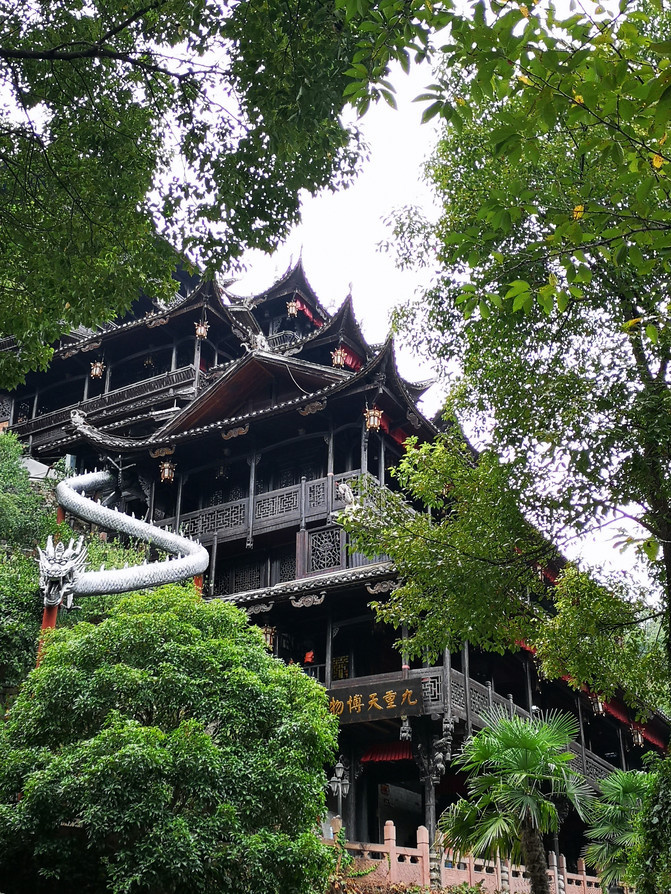
Zhangjiajie Tujia Style Park
After visiting the Tujia Style Garden, we tasted the local characteristic firewood goose at a nearby restaurant, which tasted very good.
After dinner, we went to the hotel to check in and rested early.
D5
I found that the weather was still foggy early this morning. I hope the fog on Tianmen Mountain will not be too heavy.
Tianmenshan National Forest Park is located 8 kilometers in the southern suburbs of the Urban area of Zhangjiajie City. It combines peaks, stones, springs, streams, clouds and forests. It is magnificent, strange, beautiful, dangerous and secluded. It is famous as the "majestic soul of Zhangjiajie." The mountains are surrounded by clouds and mist all year round, and the sea of clouds changes endlessly; the mountains are filled with melted hills and stone buds, there are many strange stones, beautiful trees, rare birds and animals, and there are also waterfalls and springs gushing out. Tianmen Mountain Temple on the top of the mountain is nestled among green branches and green leaves. It is quaint and clear. Tianmen Cave and General Stone are famous peak forest landscapes.
On the 1264-meter-high cliff of Tianmen Mountain, a natural door opening pierced from north to south grew. It is 131.5 meters from the bottom of the cave to the roof, 37 meters wide and 30 meters deep. At the entrance of Tianmen Gate, you can often see rock swallows flying and mountain eagles circling. As the weather changes, Tianmen Cave sometimes smokes clouds and puffs out mist, and sometimes it is as clear as a mirror, forming a cyclical and ever-changing meteorological landscape.
In order to reasonably allocate passenger flow, Tianmen Mountain needs to be entered at different times. Tickets for Tianmen Mountain also need to be booked in advance. They are divided into cableway up and down the mountain, car up and down the mountain, and car up and down the mountain. The cost of cableway and car is included in the ticket. We booked tickets for the cableway up the mountain and down the mountain from 7:00 a.m. to 9:00 a.m.. The cableway station is in the urban area of Zhangjiajie, not far from the hotel where we stayed.
Walking to the cableway company, there are already many tourists waiting to take the cableway up the mountain. It takes more than 40 minutes to take the cableway up the mountain from the cableway station. This is currently the longest cableway in the country. Sitting in the carriage, you can also see the scenery of the city and the mountains in the distance at first. When you approach Tiandongmen Gate, you can see Tianmen Cave from the side, and you can also see Tongtian Avenue halfway up the mountain. But the fog became heavier as the higher it went. By the time we stood up from the cableway, it was already white, with only the whistling wind, and nothing could be seen.
The original plan was to visit the western line from the cableway station first, to Tianmen Temple, and then from the eastern line to Tianmen Cave, thus forming a tourist loop. After waiting at the cableway station for nearly 2 hours, the fog disappeared. We had to stand up from the cableway and stroll aimlessly along the trail. The visibility was less than 10 meters. I met a tour guide on the way and said that he took a group to Tianmen Mountain, and 8 out of 10 times he encountered such weather on the mountain. Passing through Wutong Garden on the way, we could only vaguely see a few sycamore trees nearby. When we reached the escalator entrance, we decided not to move forward and went straight down the mountain from here. The escalator is built in the mountain. There are 7 sections in total, each section running for about 2 minutes. Coming out of the escalator is Tianmen Cave, but when I was in the thick fog, I didn't feel the height of Tianmen Cave.
It takes 999 steps to go down from Tianmen Cave to the parking lot. Tourists who take a car to the foot of Tianmen Cave have to climb 999 steps to reach Tianmen Cave, which requires sufficient physical strength. We went down the mountain and felt that we reached the foot of Tianmen Cave without using much physical strength. Take a bus here and pass through Tongtian Avenue back to the Cableway Company.
Tongtian Avenue starts from the Tianmen Mountain Sign Gate and reaches the foot of Tianmen Cave. It has a total of 99 turns, with a total length of more than 10 kilometers. The altitude rises from 200 meters to more than 1200 meters. It is recognized as the "first of the top ten winding mountains highways in the country". The cliffs on both sides of the avenue are thousands of high, the empty valleys are deep, and the sharp 180-degree turns disappear one after another, stacked one after another. It can be called "the world's number one highway wonder."

Tianmen Mountain National Forest Park-Tianmen Cave seen on the cable car

Tianmen Mountain National Forest Park-Tongtian Avenue seen on the cable car
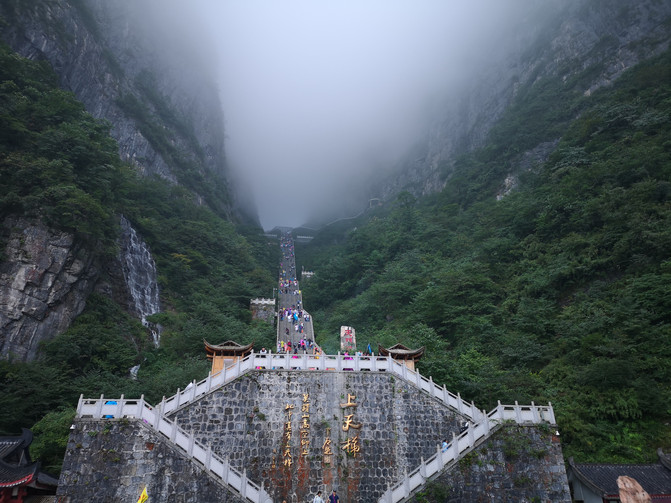
Tianmen Mountain National Forest Park-At the foot of Tianmen Cave
Go back to the hotel to pick up your luggage, change your ticket, and go to Jishou.
Because the original plan for today's trip was mainly in Zhangjiajie, I didn't want to be too rushed after arriving in Jishou early, so I didn't arrange other trips. Instead, I rested at the hotel to save strength for the next trip.
D6
Today I am going to Guzhang Hongshilin and Furong Town. In the morning, I will take a bus at Jishou Bus Station to Furong Town, and then transfer to Guzhang Hongshilin at Furong Town Bus Station. The bus from Furong Town to Hongshilin was supposed to leave at 9 o'clock, but it didn't leave until 9:30. It was already 10:30 for us to arrive at Hongshilin.
Guzhang Hongshi Forest is a rare red carbonate stone forest scenic spot formed in the Ordovician period in the world. According to geological experts, the formation of Hongshi Forest rocks has a history of about 450 million years. The Yangtze Ancient Sea known in the territorial history has a large amount of deposits on the seabed. The carbonate material of mixed mud and sand, through crustal movement, erosion and dissolution, formed this beautiful geological spectacle. There are canyons, streams, and clear springs in the stone forest, carpet-like lawns and ancient wisteria flowers, which complement each other with the red stone forest. The overall landscape is beautiful, exquisite and elegant, like a natural garden. The color of the Guzhang Red Rock Forest also changes with the weather. On sunny days, it is purple. After a shower, it turns brown-red, just like a landscape painting. After the rain, the sky becomes clear. Countless stone peaks magically change from brown-red to purplish red from the edges. At this time, the color is bright, like meticulous brushwork and heavy color. In a moment, it changes very much, which is amazing.
Most of the people visiting Hongshilin are individual tourists traveling on a self-driving tour, so there are not many people in the scenic area. Entering the scenic area, you will encounter a piece of stone pillars of various shapes. The protrusions on the stone pillars are distributed in circles of regular circular ripples. Being in the stone forest is like walking on the bottom of the sea.

Guzhang Hongshilin Scenic Area

Guzhang Hongshilin Scenic Area

Guzhang Hongshilin Scenic Area

Guzhang Hongshilin Scenic Area

Guzhang Hongshilin Scenic Area

Guzhang Hongshilin Scenic Area
After coming out of Hongshi Forest, the car back to Furong Town had not arrived yet. Because we were worried that we would have to wait for a long time, we asked the landlady at the canteen at the door to help find a car back to Furong Town. The price was 100 yuan and it was delivered directly to the Furong Town Scenic Area.
Furong Town, whose original name is Wangcun, is an ancient town with a history of 2,000 years. It is surrounded by water on three sides and has a unique cave. Since the film "Furong Town" was filmed here in 1986, with the success of the film's broadcast, tourism gradually emerged. In 2007, Wangcun officially changed its name to Furong Town.
Entering the scenic area, passing through the square, and then moving forward through Tuwang Bridge, there is a commercial street, and at the end is the "Tuwang Palace". I originally thought that I could visit the "Tuwang Palace", but it turned out that I only entered through a door on the side of the palace and walked down the stone steps to reach the waterfall.
Furong Town Waterfall is the largest and most spectacular waterfall in western Hunan. It pours down from the cliff in two levels. It is so powerful that it can be heard within a radius of ten miles. Furong Town is also known as the "thousand-year-old town hanging on the waterfall" because of the waterfall.

Furong Town Scenic Area

Furong Town Scenic Area

Furong Town Scenic Area

Furong Town Scenic Area
From the waterfall back to the parking lot, you have to climb up a flight of stone steps. There are some commercial shops on both sides. Internet celebrity Liu Xiaoqing Rice Tofu Shop is on this commercial street.

Furong Town Scenic Area-Liu Xiaoqing Rice Tofu

Furong Town Scenic Area
There are minibuses from the Furong Town Scenic Area to the Furong Town Bus Station. I stopped a passing minibus from the commercial street and returned to the bus station. When I came here, I asked clearly that the last bus back to Jishou was 5:30, but it was only 4:30 when I arrived at the bus station. It was indeed the last bus back to Jishou. Later, I chatted with the station management and learned that the cars here were all privately contracted and left when they were full. They were closed after several trains that day. Fortunately, we arrived at the bus station an hour early and caught the last bus.
D7
I basically spent the day on the train today. I took the train from Jishou in the morning and arrived at Tongren Railway Station at noon. After leaving the railway station, there are two bus stations nearby. The bus to Jiangkou is at Tongren Tourist Passenger Station. After more than an hour's drive to Jiangkou Bus Station, there happened to be a tourist bus to Fanjing Mountain. After getting on the bus, he asked that he would drive in 20 minutes, but he waited for more than an hour before driving. Local residents kept getting on and off the bus on the road. It was already past 4 o'clock in the afternoon at the foot of Fanjing Mountain.
We booked tickets to go up the mountain tomorrow and went to the hotel to check in. We decided to visit the nearby Zhaisha-Dong Village.
Zhaisha Dong Village is located at the foot of the magical Fanjing Mountain. The clear Taiping River flows slowly through the door, and ancient trees on the river reach the sky. Dong folk houses are dotted with few decorations, or hidden among bamboo and green cypresses, or entrenched on the banks of streams, or alone around the countryside, forming a natural and harmonious rural ink painting. The entire stockade is surrounded by green mountains and hidden among lush forests and bamboo trees, like a paradise.
The distance from the foot of Fanjing Mountain to Zhaisha Dong Village is 3 kilometers. Tourist buses from Jiangkou to Fanjing Mountain pass here. We had been riding by car all day and decided to walk to Zhaishadong Village. Nowadays, most of the villages are B & Bs, and there are no traces of primitive villages. After wandering around the stockade, it was not interesting. After tasting the local sour fish soup at a B & B, I returned to the hotel to rest.

Zhaishadongzhai

Zhaishadongzhai

Zhaishadongzhai

Zhaishadongzhai
D8
Tickets for Fanjing Mountain need to be booked online in advance and enter the mountain at different times. We booked tickets to enter the mountains from 8:00 to 9:00. We lived not far from the entrance of Fanjing Mountain Scenic Area. After breakfast, we set off for the scenic area.
Fanjing Mountain is located at the junction of Yinjiang, Jiangkou and Songtao counties in Tongren City, Guizhou Province, China. It is the main peak of the Wuling Mountains and the Lingshan Mountain in eastern Guizhou. It is an ecological kingdom, a scenic resort and a pure land. The mountains throughout the territory are majestic, with endless peaks; steep slopes and deep valleys, and towering peaks; streams are crisscross and crisscross, and waterfalls are hanging; the special geological structure formed by ancient geology has created its diverse and majestic mountain landscape. The fame and development of Fanjing Mountain originated from Buddhism. The huge temple groups throughout the Fanjing Mountain area have established Fanjing Mountain's Buddhist status as the famous "Ancient Buddha Dojo". It is the only Maitreya Bodhisattva Dojo among China's five famous Buddhist mountains. Buddhist culture has covered the vast Fanjing Mountain with a solemn and magical color. The main attractions include Mushroom Stone, Old Jinding, Hongyun Jinding, etc.
There are already many people waiting there at the entrance of the scenic spot, but most of them are tour groups, waiting for the guide to buy tickets. We soon entered the scenic area.
To enter the scenic spot, you must first take a sightseeing bus to the cableway station, then take the cableway up the mountain, and then walk to various attractions. When we arrived at the cableway station, we found that there was a long line of people waiting to go up the mountain. After waiting in line for about 20 minutes, we took the cableway to the mountain. After leaving the cableway station, I found that the mountain was filled with fog and nothing could be seen clearly. But now that we were already here, we decided to go up the mountain to have a look.
The first thing you will reach along the pedestrian path is Mushroom Stone. Mushroom Stone is a famous landscape with a large top and a small bottom. It is about ten meters high. It has stood on the mountain for 1 billion years and is a sacred place for taking photos. But at this time, the mushroom stone was hidden in the fog, and many people took photos here. We did not stop and continued to climb towards the old golden summit.
There is a viewing platform going up from the mushroom stone. When we arrived at the viewing platform, the clouds and clouds dissipated slightly, and we could vaguely see the mountains in the distance. It is still almost 200 meters away from the old Jinding. It will be a surprise to meet some tourists coming down from above. Driven by curiosity, we continued to climb upwards. The road was very steep. After more than half an hour, we reached Laojinding.
Laojinding is 2494 meters above sea level and has a lantern hall above it. The top of the mountain is shrouded in clouds and mist, and waves of mountain winds blow the fog away. The red clouds and gold tops opposite and the mountains in the distance are hidden and hidden in the clouds and mist.
The Hongyun Jinding Peak stands upright and is 100 meters high. The upper half is divided into two, and the two ends are connected by a overpass. There is a temple built on each side, dedicated to Shakya Buddha on one side and Maitreya Buddha on the other. Red clouds often surround the surroundings, and they are called the Red Cloud Golden Top, or the "Golden Top of Fortune". It is shaped like a flying dragon, like a Buddha's finger meditation, and more like a human life totem. According to its shape, it is also called "the first peak in the world".
This time, I planned to go to the Hongyun Jinding, but the Hongyun Jinding is under maintenance and is not open to tourists. I can only stand on the old Jinding and have a look from afar.

fanjing mountain

Fanjing Mountain--A distant view of the Red Cloud and Golden Roof

fanjing mountain

fanjing mountain

Fanjing Mountain-Lao Jinding
When I came down from Laojinding and passed the mushroom stone again, the clouds and fog had already cleared. The mountains in the distance looked like a beautiful picture against the blue sky.

fanjing mountain

fanjing mountain

Fanjing Mountain-Mushroom Stone

fanjing mountain

fanjing mountain
We took photos while walking, and it was already past 1 o'clock when we arrived at Purdue Square. After taking a break here, I met a tour guide. According to the tour guide, we were lucky to have a sunny day today. He reminded us that there are many people today and we should go to the cableway station early to queue up.
There is a Pudu Temple next to Pudu Square. We walked around the temple and headed for the cableway station. There was a long queue on the mountain road some distance away from the cableway station. It took more than an hour for us to take the cableway back to the foot of the mountain.
Take a sightseeing bus to the gate of the scenic area and end our trip to Fanjing Mountain.
D9
Today we are leaving Fanjing Mountain and heading to Shiqian County to soak in hot springs. Shiqian County is a famous hometown of hot springs. Take the bus that goes directly to Shiqian County at 9:30 from the Jiangkou County Bus Station and arrive at Shiqian County at noon. I have made a reservation at Shiqian Hot Spring Resort Hotel. After getting on the bus, I told the driver that I would get off when passing by the hotel.
The hotel we booked allowed free hot springs. After checking in, we went to the hot springs.
Shiqian Hot Spring is also known as Chengnan Hot Spring. It is located at the foot of Songming Mountain in the south of Shiqian County, Guizhou. It is one of the oldest hot springs in China. Its facilities were built in the 34th year of Wanli of the Ming Dynasty (1606 AD) and have lasted for more than 400 years. It has a unique traditional bathing culture. It is the only natural mineral hot spring in the country and one of the few in the world that can both take a bath and drink directly.

Shiqian Hot Spring

Shiqian Hot Spring

Shiqian Hot Spring

Shiqian Hot Spring
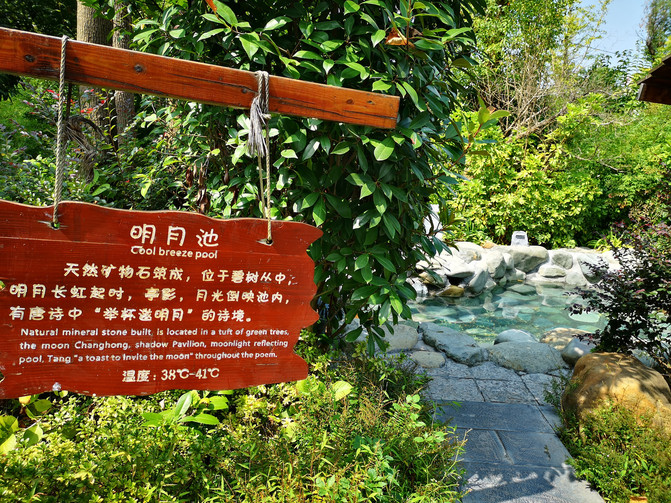
Shiqian Hot Spring

Shiqian Hot Spring
The street not far from the hotel is a very lively market. After soaking in the hot spring all afternoon, we walked around the market in the evening to experience the local people's life.

Shiqian Hot Spring

Shiqian Hot Spring--Fairy Tofu

Shiqian County
D10
After breakfast in the morning, we went to the hot spring for a while. It was almost noon to check out and prepare to take the bus to Zhenyuan at around 12 o'clock. Because I had not booked the ticket in advance, I didn't know when I arrived at the bus station that the tickets for around 12 o'clock had been sold out, so I had to wait for the 2 o'clock bus to go to Zhenyuan.
Zhenyuan Ancient Town has a history of more than 2200 years and is a national key historical and cultural city. The Wuyang River passes through the city in an "S" shape. On the north bank is the old Fucheng City, and on the south bank is the old Acropolis. From a distance, it looks like a Tai Chi diagram. Ancient streets and alleys in the city lead to secluded areas, with scattered stone bridges and city walls, colorful clear water and morning fog, and poetic fishing fires on the spring river. There are more than 160 ancient buildings in Qinglongdong, a national key cultural relics protection unit, which are majestic and unique and famous at home and abroad. Ancient houses, ancient alleys, ancient docks, and ancient city walls in the Ming and Qing Dynasties, with high ornamental value and scientific research value. Its architectural style is blue bricks and black tiles, high-sealed fire walls, cornices and curved corners, and carved beams and painted buildings. Every bluestone slab and every blue brick records historical relics, weeping about the vicissitudes of the thousand-year-old ancient town. Wang Yangming in the Ming Dynasty, Lin Zexu and He Shaoji in the Qing Dynasty and other historical celebrities left traces here. Today, there are many stele inscriptions on cliffs.
It was already past 4 o'clock in the afternoon when I arrived in Zhenyuan, so the original plan to visit Qinglong Cave had to be cancelled. I put down my luggage and went directly to visit Zhenyuan Ancient Town.
Take bus No. 1 from Zhenyuan Railway Station and get off at Sifangjing Station. You will see Sifangjing Lane if you walk forward a short distance. Walking up the stone steps, you can see an ancient well at a corner. It is said that it was built in the Song and Yuan Dynasties and is named because the wellhead is square. There are well-preserved ancient houses on both sides of the alley, and most of the houses are still inhabited. Halfway up the mountain, you can see the appearance of Qinglong Cave, a well-preserved ancient building complex. Continue climbing upwards and you will reach the viewing platform of Yuping Mountain. The viewing platform can overlook the entire Zhenyuan City and is also a good place to watch the lights of Zhenyuan City. When we arrived at the viewing platform, we just caught the sunset. The lights on both sides of the Wuyang River were bright, and the green water passed through the city like a jade belt. Zhenyuan City looked more and more beautiful against the sunset.

Zhenyuan ancient town

Zhenyuan Ancient Town--Sifang Well

Exterior view of Qinglong Cave, Zhenyuan Ancient Town

Zhenyuan Ancient Town-A View of Zhenyuan on Yuping Mountain

Zhenyuan Ancient Town-A View of Zhenyuan on Yuping Mountain

Zhenyuan Ancient Town-A View of Zhenyuan on Yuping Mountain
After coming down from Yuping Mountain, I walked down the street and unwittingly arrived at Zhusheng Bridge, an ancient bridge built in the Ming Dynasty. We stayed on Zhusheng Bridge for a while and enjoyed the beautiful scenery of the lights on both sides of the Wuyang River. After dinner on the Wuyang River, we returned to the inn to rest.

Zhenyuan Ancient Town-Night View of Qinglong Cave

Zhenyuan Ancient Town-Night View of Wuyang River

Zhenyuan Ancient Town-Night View of Yuping Mountain

Zhenyuan Ancient Town-Night View of Zhusheng Bridge

Zhenyuan Ancient Town-Fish in Sour Soup
D11
It took more than 4 hours to arrive in Guiyang by train from Zhenyuan in the morning. We put down our luggage and went directly to Erqi Road Snack Street.
Guiyang Erqi Road Snack Street is located at the junction of Jiefang Road and Shachong Road in Nanming District, Guiyang City. It is a nearly 400-meter-long commercial pedestrian snack street that operates various traditional snacks from all over Guizhou. Here is a collection of famous snacks from all over Guizhou, such as Changwang noodles, Qingyan pork knuckle, Huaxi beef noodles, Leijia tofu dumplings, etc., which makes people feast.
Snack Street on Erqi Road in Guiyang is not far from the railway station and can be reached in ten minutes on foot.

Snack Street, Erqi Road, Guiyang

Guiyang snack-ice powder

Guiyang snack-glutinous rice porridge

Guiyang snack-roasted rice skin
After eating our fill here, we took a bus to Jiaxiu Building, a landmark building in Guiyang, to check in.
Jiaxiu Tower is located on the Nanming River south of Guiyang City, Guizhou Province. It is built on a huge rock in the river. It was built in the Ming Dynasty and has undergone six large-scale repairs. It still stands after four hundred years of wind and rain. The existing building was rebuilt in the first year of Xuantong (1909). It is a witness to the history of Guiyang and a symbol in the history of Guiyang's cultural development. Jiaxiu Building is surrounded by red beams and green tiles, surrounded by water, light and mountains. The name matches the reality, and it can be called Jiaxiu.

jiaxiu building
Coming out of Jiaxiu Building, I came to the adjacent Cuiwei Pavilion.
The Cuiwei Pavilion in Guiyang was built during the Hongzhi period of the Ming Dynasty ( 1488 - 1505). It is an ancient building complex that dug mountains and built platforms along the central axis, rose layer by layer, and connected by corridors and rockery on both sides. Ten steps up from the main entrance of the mountain gate, you can reach Gongnan Pavilion, with white walls and green pillars, flying eaves and angled corners, and gold plaques hanging high high. Its shape can be seen vividly in the simplicity. To the west of the pavilion is the Longmen Academy, which is shaded and quiet. The corridor is surrounded by flower walls, integrating tranquility, elegance, heroism and simplicity. In the east of the pavilion, there are clear flowers and clear green gardens. There are dancing bamboos and strange stones in the garden. Around the corridor and flower walls, the dignified and beautiful Cuiwei Pavilion stands in it.

Cuiweige

Cuiweige

Cuiweige

Cuiweige
It was past 5 o'clock when we left Cuiwei Pavilion, and we returned to Erqi Road Snack Street to continue eating and drinking.

Guiyang snack-sour soup powder

Guiyang snack-Changwang noodles
D12
You can take cars, trains and planes from Guiyang to Libo. Cars and trains take a long time. We got a discount on the ticket for catching up this time, so we chose to fly to Libo. The plane takes 40 minutes to arrive at Libo Airport, and take a bus from the airport directly to the east gate of Xiaoqikong Scenic Area. Before coming here, I was worried that it would be inconvenient to travel from the airport to the scenic spot. When I arrived here, I realized that the airport bus here is scheduled according to the flight time, so it is still very convenient.

Libo airport
It is about a 40-minute drive from Libo Airport to the east gate of Xiaoqikong Scenic Area. The inn we booked is located in Mengliubuyi Town opposite the east gate of the scenic area. It is an immigrant town with ethnic characteristics. Most of the residents in the town run inns or Catering services.
Tickets for the scenic spot include the Daqikong Scenic Area and the Xiaoqikong Scenic Area and are valid for two days. The Big Seven Hole Scenic Area is not large. It is named after the ancient Bridge of the Big Seven Hole that enters the scenic area. You can visit it on foot or by boat. The Xiaoqikong Scenic Area has an ancient Xiaoqikong Bridge built in the 15th year of Daoguang (1836). The name of the scenic area is derived from the bridge. The Xiaoqikong Scenic Area requires a sightseeing bus to reach various attractions. Tickets for the scenic spot have been booked online. Since there is only half a day today, after collecting the tickets at the Visitor Center, we decided to visit the Big Seven Hole Scenic Area first.
The Daqikong Scenic Area is located in the southern part of Libo, Qiannan, Guizhou. It is a scenic area with virgin forests, canyons, downflows, and underground lakes as the main body. Going up from the Daqikong Bridge, you will encounter a long Tianshen Canyon. Inside the canyon, dangerous cliffs are stacked, towering cliffs are shrouded in mist. A natural bridge carved by nature with extraordinary craftsmanship has been praised by experts as the "Eastern Arc de Triomphe Created by the Divine Power of Nature". It is awe-inspiring and impressed by the Divine Power of Nature. The rapid water under the bridge forms a waterfall. Stalactites of various shapes are scattered under the bridge holes. The sides of the bridge are covered with shrubs, flowers and plants, and the beautiful scenery is dizzying.
After entering the scenic area, you can visit it on foot or by boat. Many tourists who are in a hurry come here to check in after visiting the Xiaoqikong Scenic Area, and then rush back to Libo County, so most of them are in a hurry. We had plenty of time, so we chose to walk and slowly appreciate the scenery on both sides of the Taiwan Strait. The trail is built along the river. Along the way, you can see the lush trees on both sides. The river water sandwiched in the cliffs is like a piece of jasper. The peaks and trees on both sides are reflected on the water surface, forming a beautiful reflection. From time to time, cruise ships pass by, forming ripples on the water.

Daqikong Scenic Area-Daqikong Bridge

Daqikong Scenic Area

Daqikong Scenic Area
When we arrived at Tiansheng Bridge, the river bed became shallower and the color of the river water also appeared in different shades. The bridge body is covered with green vegetation, and many stalactites of various shapes hang from the cliffs of the bridge holes, which are beautiful against the backdrop of light and shadow.

Big Seven Hole Scenic Area-Tiansheng Bridge

Daqikong Scenic Area

Big Seven Hole Scenic Area-Tiansheng Bridge

Daqikong Scenic Area
Walking further to the Demon Wind Tunnel, you will reach the end of the Big Seven Hole Scenic Area. Return to the Gorge of Terror, from the suspension bridge to the opposite bank, and follow the trail on the other side back to the entrance of the scenic area.

Daqikong Scenic Area

Daqikong Scenic Area
In the evening, there are song and dance performances in the town square. After tasting the food with ethnic characteristics in the town, we returned to the inn early to rest and prepare for tomorrow's trip to Xiaoqikong.
D13
Xiaoqikong Scenic Area is located in the southwest of Libo County, Guizhou Province. It is a national-level scenic spot. The long and narrow valley, which is only 1 kilometer wide and 12 kilometers long, integrates various landscapes such as caves, forests, lakes, waterfalls, stones and water. It is exquisite and beautiful, making tourists always new. It has the reputation of "emerald on the earth" and "super bonsai". The main attractions include Xiaoqikong Ancient Bridge, Laya Waterfall, 68-level Diushui Waterfall, Water Forest, Yuanyang Lake and Wolong Lake.
Xiaoqikong Scenic Area is a must-see place when coming to Libo. In order to avoid tour groups, we entered the scenic area early in the morning. The first stop by the sightseeing bus is the Xiaoqikong Ancient Bridge, an ancient bridge with a long history. The bridge is made of hemp stone strips. The bridge body is covered with vines and ferns. Under the antique bridge is an intoxicating green Han Bi pond. Ancient trees on both sides of the river reach the sky, and huge branches stretch their arms along the bridge, like giant umbrellas supported on the bridge. Many Xiaoqikong scenery postcards are taken here, which is also a must-visit place for tourists. We came early and there weren't many people on the bridge yet. We could take photos here as much as we wanted.
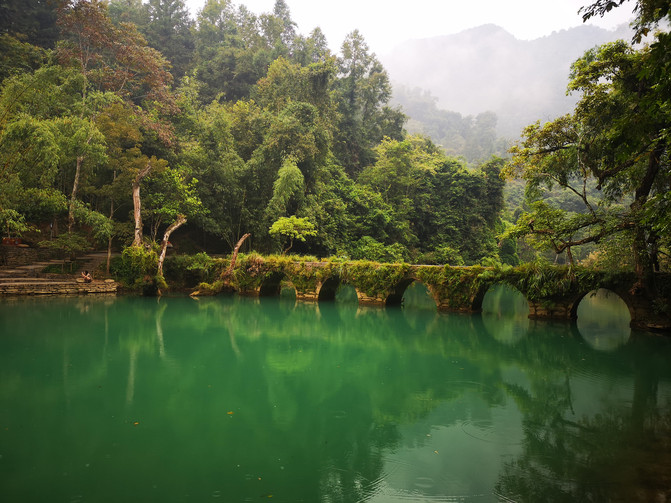
Xiaoqikong Scenic Area-Xiaoqikong Ancient Bridge

Xiaoqikong Scenic Area-Xiaoqikong Ancient Bridge
When the next sightseeing bus arrives, there are gradually more tourists on the Xiaoqikong Bridge. We left here and walked slowly along the plank road.
In the 1.6-kilometer-long narrow valley upstream of Hanbitan, along the high and low river bed, there are 68-level waterfalls and falling waters. The cascading waterfalls pour down with gurgling gurgling sounds, some pouring pearls and jade, pushing snow and embracing clouds, or like flowing rivers, like the Milky Way pouring down the ground, with various shapes and myriad phenomena. Various waterfalls compete to lead the way, competing for wonders, forming a dynamic waterscape with a variety of customs, which makes tourists dizzying. Such many and dense waterfalls and waterfalls are rare in the country.

Xiaoqikong Scenic Area

Xiaoqikong Scenic Area

Xiaoqikong Scenic Area

Xiaoqikong Scenic Area
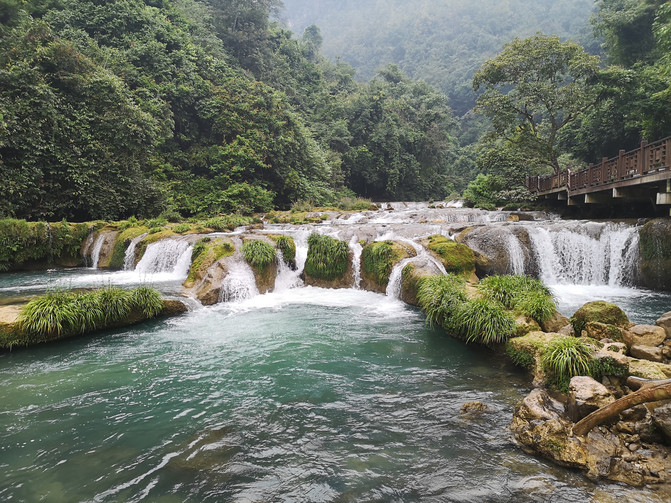
Xiaoqikong Scenic Area--Level 68 water drop
Climb up the cascade waterfalls along the river and valley, and soon arrive at Raya Waterfall. I saw the waterfalls bursting into the sky and falling horizontally, forming a wonderful three-dimensional intersection waterfall landscape with the 68-level waterfalls falling vertically in the Xiangshui River. The water mist splashing from the waterfall is fluttering and fluttering, giving tourists a cool and beautiful enjoyment.

Xiaoqikong Scenic Area-Laya Waterfall

Xiaoqikong Scenic Area--Level 68 water drop
After visiting the 68-level Falling Waterfall, we took a sightseeing bus to the water forest.
The aquatic forest is a famous landscape in Libo Xiaoqikong Scenic Area. It belongs to the rare karst landform aquatic forest area. Thousands of trees here are all rooted on the hard rocks in the water and take root in the water through the hard rocks. River bed. There are stones in the water, trees on the stones, and trees are planted in the water. This wonderful scene of water, stones, and trees leaning against each other is amazing. From a distance, it looks like a forest floating on the water.
The water forest is divided into upper, middle and lower sections. People can walk in the water in the upper and lower sections, but the stones in the water are relatively slippery, and they will step on them if you are not careful.

Xiaoqikong Scenic Area-Water Forest

Xiaoqikong Scenic Area-Water Forest
At the end of the water forest, you can take a car to the next attraction-Cuigu Waterfall. It was already past 1 o'clock in the afternoon when we arrived at Cuigu Waterfall, and there were many people gathered here.

Xiaoqikong Scenic Area-Cuigu Waterfall
After a brief photo shoot at Cuigu Waterfall, we went to Yuanyang Lake.
Yuanyang Lake is a wonderful water network composed of two large lakes and four small lakes in series. It is a group of plateau karst lakes. The bank of the lake is rugged, with crisscrossed teeth, surrounded by thick shade; the lake water is lush and unpredictable, and the lake water is constant throughout the year. Between the green islands, the harbors are intertwined, and the water surfaces are intertwined, forming a water maze. The narrow place is like a tree-lined alley on the water, and the open place is like a giant window in a forest on the water. In the morning and evening, thick fog is like milk, covering the lake, making it hazy and hazy, making it more wild and interesting.
Most tourists who come to Yuanyang Lake have to go boating. We are no exception, enjoying ourselves in the blue waves.

Xiaoqikong Scenic Area-Yuanyang Lake

Xiaoqikong Scenic Area-Yuanyang Lake

Xiaoqikong Scenic Area-Yuanyang Lake
Come out of Yuanyang Lake and continue to take the bus to Wolongtan.
Wolongtan, formerly known as Weng Longtan, is the exit of the Wolong River, a karst underground river. The underground river gushed out from the bottom of the cliff, but was nowhere to be seen on the surface of the pool. Only the avalanche like rolling waterfalls on the dam could I feel the Wolong River turning at the bottom of the pool. There are many strange rocks and strange trees beside the pool, and ancient trees are dense. The sound of water outside the pool is roaring, and the mountains are shrouded in fog and rain. The surrounding mountains are locked, and the pool is like an underground abyss.
The water in Wolong Lake is intoxicating, and the white clouds in the sky, the mountains and trees on the bank are reflected in the pool of clear water, like an oil painting in front of your eyes.

Xiaoqikong Scenic Area-Wolongtan

Xiaoqikong Scenic Area-Wolongtan
After 5 p.m., we took a bus from Wolongtan back to the town. Since we have to take a bus from Libo County to Huangguoshu early tomorrow morning, we made a reservation for accommodation in Libo County today. After picking up your luggage, take bus No. 11 at the east gate of the scenic area and arrive at Libo County in 40 minutes.
D14
Depart from Libo County in the morning, transfer to the shuttle bus to Huangguoshu in Anshun County, and arrive at Huangguoshu Town at around 2 p.m. Put down your luggage and go directly to the visitor center to buy tickets.
Huangguoshu Scenic Area is located in the southwest of Guizhou Province. It consists of 18 waterfalls of different sizes. It is a typical karst area with beautiful scenery, mild climate and abundant rainfall. It is a national key scenic spot. The scenic spot consists of Huangguoshu Waterfall, Doudoutang Waterfall and Tianxingqiao Scenic Area, forming a huge "family" of waterfalls and "group" of waterfalls, of which Huangguoshu Waterfall is the most beautiful and spectacular.
You can take a bus from the visitor center to various scenic spots. Due to the better light in the afternoon and to avoid the flow of people, we first chose to go to the Huangguoshu Waterfall Scenic Area.
Huangguoshu Waterfall is the core scenic spot of Huangguoshu Scenic Area. It is 77.8 meters high and 101.0 meters wide. It is a typical erosion and crack waterfall in the karst landform. It is the largest waterfall in China and one of the world's famous waterfalls.
To enter the scenic area, you must first pass through a bonsai garden before you can see the Great Waterfall. Before I even reached the waterfall, I heard the deafening sound of water. When I got closer, I saw a 100-meter wide water curtain pouring down from a height of tens of meters. The water mist formed dissipated with the wind and permeated the surroundings. It was quite shocking. Fortunately, we saw a rainbow in the mist.
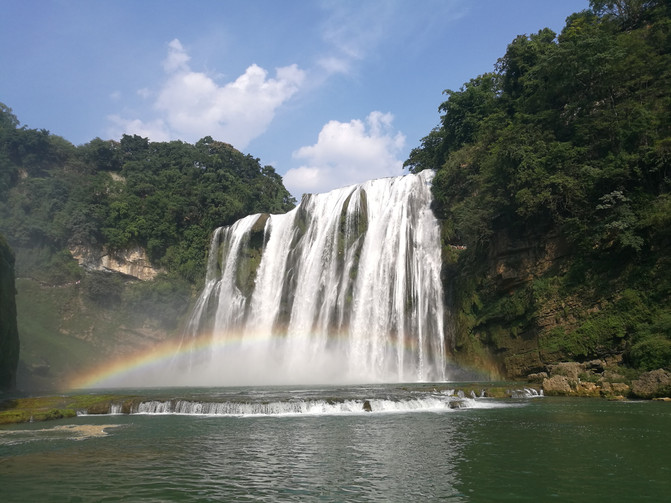
huangguoshu waterfall
Climbing up the stone steps, you can cross the Water Curtain Cave and enjoy the scenery behind the waterfall. Huangguoshu Waterfall is the only waterfall in the world that can be viewed from six directions: top, bottom, left, right, front and back. It is also the waterfall in the world that has a water curtain cave naturally runs through and can be seen, heard, viewed and touched from inside the cave.

huangguoshu waterfall

huangguoshu waterfall
After circling the waterfall and enjoying the waterfall from different angles, we took a bus to Doudoutang Waterfall.
Doudoutang Waterfall is located 1 kilometer upstream of Huangguoshu Waterfall in Guizhou Province. The waterfall top is 105 meters wide and 21 meters high. It is the widest waterfall among the Huangguoshu Waterfalls. On top of the Douputang Waterfall is a huge melting pool with an area of 15,000 square meters, and the waterfall is formed on a calcified beach dam that is more than 100 meters long. The water layer of the waterfall spreads evenly along the gentle waterfall surface and dances lightly on the scaly tufa beach, like a thin, translucent veil, or like an open silk fan. It shines silver in the sun, so some people jokingly call it the "bride's veil." Doudoutang Waterfall is also the waterfall that Tang Priest and his disciples walked through at the end of "Journey to the West" filming in the 1980s.
Doudoutang Waterfall Scenic Area is not large. You can reach the waterfall within a few minutes of entering the scenic area. Although Douputang Waterfall is not as high as the waterfall, it is wider than the waterfall. The water layer flows down like a gauze, splashing droplets of water like pearls. I still like it here. The fly in the ointment is that the sun had already set when we arrived at Doudoutang Waterfall, and the light was not very good. We took a few photos in the afterglow of the sunset and left.

Doudoutang Waterfall
D15
Take the scenic sightseeing bus to Tianxing Bridge Scenic Area in the morning.
Tianxing Bridge Scenic Area is located 7 kilometers downstream of Huangguoshu Waterfall. There are three connected areas here, namely, Tianxing Bonsai Area, Tianxing Cave Scenic Area, and Water Stone Forest Area. It mainly ornamental the wonderful combination of stones, trees and water. It is a natural bonsai area transformed into water stone forest. The scenic area is densely populated with stalagmites and lush vegetation. It integrates mountains, water, forests and caves. It is praised by tourists as the "Wanjiang Bonsai" carved with wind knives and water swords ", and the" ancient masterpiece "with" roots, rattan and ink painted with silk ".
Entering the scenic spot, there is a stone road in the pond. Each stone is engraved with a date, so that you can find your birthday stone. Later, we will pass through scenic spots such as Beauty Banyan and reach Gaolaozhuang. This is a resting area. The visit of ordinary tourist groups to the Tianxing Bridge Scenic Area here will end.
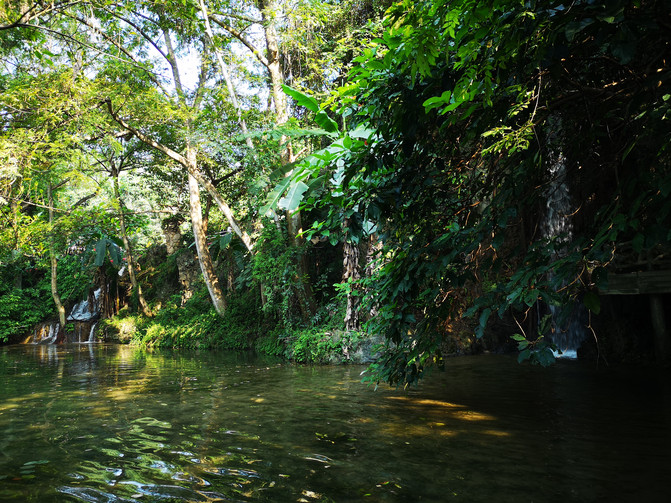
Tianxing Bridge Scenic Area

Tianxing Bridge Scenic Area

Tianxing Bridge Scenic Area
However, the essence of Tianxing Bridge Scenic Area is in the second half, turning around Gaolaozhuang and going up the path, with endless beautiful scenery along the way. Halfway up the mountain there is Tianxing Cave, which is a karst cave. There are many stalagmites, stalactites, stone pillars, etc. In it, one of the stone pillars is said to be the location where the Dinghai Divine Needle in the 80th edition of Journey to the West was photographed. Because I have seen many caves, I don't think there is anything special here.

Tianxing Bridge Scenic Area--Bridge on Bridge on Bridge

Tianxing Bridge Scenic Area-Tianxing Cave

Tianxing Bridge Scenic Area-Tianxing Cave
Coming out of Tianxing Cave and moving forward, you will reach the essence of Tianxing Bridge Scenic Area-Silver Chain Falling Pond. There was a calm pool above. The water passed through a cliff. Since the stones around them were tilted towards the middle, under the reflection of the sun, the water flowed evenly across the stones, fell sharply, and merged into the gap in the middle, stirring up a group of snow-white foam, glowing with white light, galloping in the narrow valley with the rapids.

Tianxing Bridge Scenic Area-Silver Chain Falling Pond

Tianxing Bridge Scenic Area-Silver Chain Falling Pond
After passing the Silver Chain Falling Pond, you will reach the exit of Tianxing Bridge Scenic Area. There is a commercial street here. It was still early, so I wandered around the commercial street and found that Gaolaozhuang was on the other end of the commercial street. There were many people in the morning and we missed some of the scenic spots in front. We decided to return to the entrance of the scenic spot from the original road of Gaolaozhuang to enjoy the scenery along the road. After more than an hour, we returned to the entrance of the scenic area.

Tianxing Bridge Scenic Area

Tianxing Bridge Scenic Area
After coming out of the scenic area, I took a bus back to the town, and ended today's trip.
D16
Today, I have to take the afternoon train to Maitreya to soak in the hot spring. I heard that there is a Shitou Village near Huangguoshu. The houses and daily necessities are all built of stone. I decided to go to Dingshitou Village in the morning.
Huangguoshu Shitou Village is a Buyi mountain village on Biandan Mountain. It is surrounded by mountains and rivers. It is surrounded by beautiful mountains. There are fields in front of the village. There are green trees behind the village. The winding Baishui River passes around the village.
You can take an electric tricycle from Huangguoshu Town to Shitou Village. The driver took us to Shitou Village entrance and agreed to call him when we went back, and he would pick us up. Arriving here, I found that most of the houses in the stockade had been renovated, but they were similar in appearance. There were actually few stone houses left. On the way, I met an old grandma and enthusiastically led us to find several remaining stone houses halfway up the mountain. The most distinctive thing is that the roof of the stone house is made of stacked stone slices. When viewed from the outside, the stone slices are stacked on top of each other without a crack. When viewed from the inside, the roof is filled with stars of light. There are some living utensils such as stone vats and stone basins that are still in use in the house.
During the conversation, I learned that the old grandma was a local inheritor of batik skills and a winner of the National May Day Labor Medal. After walking around the stockade, I bought several batiks made by my old grandmother as a souvenir. Coming out of Shitou Village, the Baishui River in front of the stockade is still very beautiful.
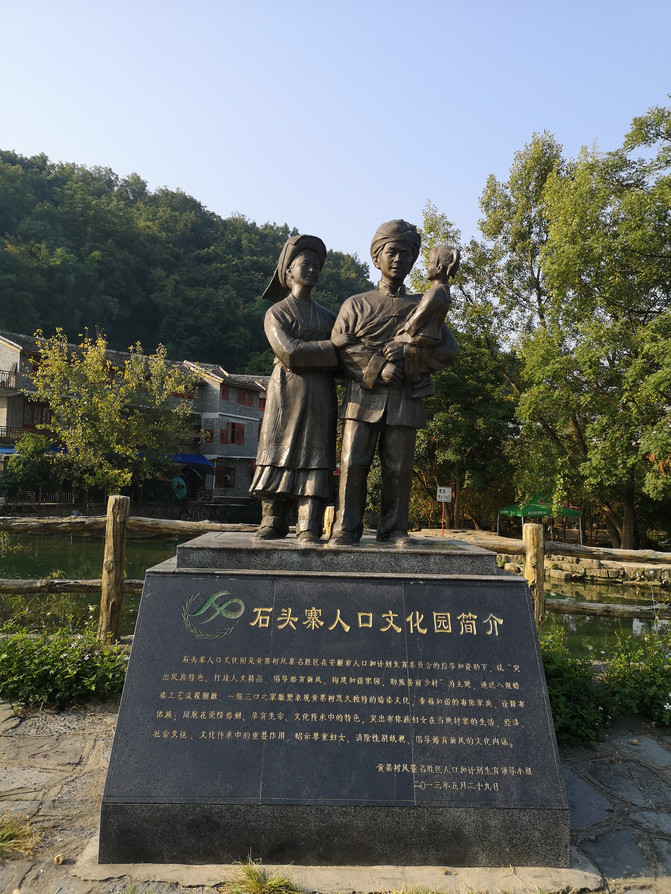
shitouzhai

Shitou Village-the surviving stone house

Shitou Village-Baishui River in front of the village

Shitou Village-Baishui River in front of the village
Coming back from Shitouzhai, we took a bus to Anshun West Railway Station, and from here we took the train to Maitreya via Kunming. If you transfer at Kunming Railway Station, if the next train leaves within 40 minutes, you don't have to leave the station. You can transfer directly at the station.
Maitreya is rich in geothermal resources, especially famous for its Xiaoqintian Hot Spring in the northeast of the city, Meihua Hot Spring in the west of the city, and Xiaozhai Hot Spring in the south of the city.
We arrived at Maitreya at around 8 p.m., and the car from the hotel that we booked to pick us up was already waiting for us outside the high-speed rail station.

Milejia Yuquan·Tianchi Du Hot Spring Resort

Milejia Yuquan·Tianchi Du Hot Spring Resort

Milejia Yuquan·Tianchi Du Hot Spring Resort

Milejia Yuquan·Tianchi Du Hot Spring Resort
D17
There were no arrangements today. The driver who picked us up yesterday said that it was very convenient to drive from the hotel to Dongfeng Yun Scenic Area, so he decided to go for a stroll.
Dongfeng Yun Scenic Area was founded in 2014. The entire scenic area covers a variety of industries such as ecological agriculture, art culture, leisure, vacation and health preservation, including lavender manor, lavender theme park and lavender service display center, wine manor, artist manor, rose manor, lily manor, forest park, lakeside wetland, quiet valley, agricultural and sideline tourism product processing base, etc., is a national AAAA modern agricultural tourism complex integrating high-end leisure and health vacation.
But the scenic spot has not been built yet. I walked around it, maybe it was the wrong season and I didn't see many flowers. I didn't think it was interesting, so I came out before I finished shopping.

Dongfeng Yun Scenic Area

Dongfeng Yun Scenic Area

Dongfeng Yun Scenic Area
Previously, I made a guide and saw that there is a Yunnan Red Wine House nearby. It is a national agricultural tourism demonstration site that focuses on grape tourism, integrates tourism, catering, entertainment, accommodation and reception, and integrates business, leisure, nature and quality. I carpooled directly to Yunnan Red Wine House at the entrance of Dongfeng Yun Scenic Area.
When you enter the wine house, you will first watch a video introducing grapes and wine. After waiting for a while, several more people came, and a guide showed us around the winery. The tour guide took us to the wine cellar and explained some knowledge about wine. Since it was not the grape harvest season, the wine-making process was not seen.

Yunnan Red Wine Restaurant
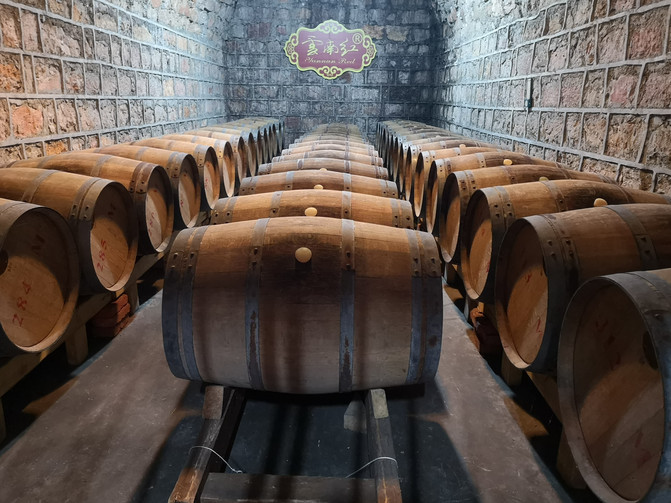
Yunnan Red Wine Restaurant

Yunnan Red Wine Restaurant
Return to the hotel from the wine shop and continue your leisure time surrounded by hot spring water.
D18
The end of this trip is to visit old friends in Puzehei. After breakfast in the morning, we took a dip in the hot spring for a while, and checked out and went to Puzehei.
It only takes half an hour to take the high-speed train from Maitreya to Puzehei. Coming out of the Puzehei High-speed Railway Station, friends we haven't seen for a long time are already waiting for us.
The first day I arrived in Puzhei was spent reminiscing among friends.
D19
Puzehei Karst National Wetland Park is located 3 kilometers north of Qiubei County. It is a typical karst karst landform. It is famous for its six major landscapes: water pastoral, lake peak forest, Yi water town, karst wetland, lotus world, and migratory bird paradise. The scenic area is dotted with lonely peaks, various karst caves, and connected lakes. Puzhei Village is the third location of the first season of the 2013 Hunan Satellite TV's large-scale parent-child show "Where Are We Going, Dad?".
In order to avoid the hustle and bustle of the city, we booked an inn in Puzehei Village, which is also the core scenic spot of Puzehei Scenic Area.
The whole village was very quiet in the morning. After breakfast, we followed the path in the village to the foot of Qinglong Mountain. Qinglong Mountain is not high, but the mountain road is not easy to walk. After more than half an hour to reach the top of the mountain, you can overlook the entire Puzehei Village.

Puzhehei Scenic Area-Qinglong Mountain

Puzhehei Scenic Area-Qinglong Mountain
There were not many people when we arrived at the top of the mountain. We stayed for a while and the number of people gradually increased. After getting down from Qinglong Mountain, you can walk along the road for about 15 minutes to reach the online celebrity tourist attraction check-in spot-the location of the TV series "Three Lives of Ten Miles Peach Blossom".

Puzhei Scenic Area--The location where "Three Life and Ten Miles Peach Blossom" was filmed

Puzhei Scenic Area--The location where "Three Life and Ten Miles Peach Blossom" was filmed

Puzhei Scenic Area--The location where "Three Life and Ten Miles Peach Blossom" was filmed

Puzhei Scenic Area--The location where "Three Life and Ten Miles Peach Blossom" was filmed
The main means of transportation in the Puzhei Scenic Area is carriage. After returning from the location shooting site of "Three Lives of Ten Miles Peach Blossom", you can take a carriage back to Puzhei Village. After resting at the inn in the afternoon, we continued to reminisce among friends.
D20
A friend drove us to pick us up early this morning to Shede Grassland.
Shede Grassland is located in the northwest of Qiubei County and is mainly famous for its grassland and plateau scenery. In the scenic area, there is Yangxiong Mountain, the highest peak in Qiubei County, with an altitude of more than 2500 meters. The mountain is covered by virgin forests and ancient trees reach the sky. Although the 100,000-acre grassland is not as vast as the Inner Mongolia grassland, it does not lose the unique taste of the grassland. On the grassland at an altitude of more than 2000 meters, you can see the rolling terrain, the sky is rolling with clouds, and cattle and sheep are seen in the wind and grass. It is known as the "Little Shangri-La" of Wenshan.
Shede Caochang is a wind farm, and huge windmills can be seen everywhere on the mountains. The wind is very strong on the mountain, and the clouds are rolling in the wind like snow-white cotton wool.

Shede Caochang

Shede Caochang

Shede Caochang
Coming down from the mountain, there is a large grassland halfway up the mountain. Although it is not as vast as the grassland in western Sichuan, you can ride horses here and watch the sea of flowers without losing the unique charm of the grassland.

Shede Caochang

Shede Caochang

Shede Caochang
D21
Today is the last day of this trip. In the morning, I strolled around the peaceful village and took a bus to Puzehei High-speed Railway Station and took the high-speed railway to Kunming.
It was already noon for the train to arrive in Kunming, and the flight we booked was after 8 p.m. After storing our luggage, we took the bus to Guandu Ancient Town.
Guandu Ancient Town is located in the south of Kunming City. It is a famous historical and cultural town and one of the birthplaces of ancient Yunnan culture. Historically, Guandu was an important ferry crossing for ships in Dianchi Lake. It was also a market town with relatively developed politics, economy and culture on the main transportation route to southern Yunnan. It was known as "Little Yunnan" during the Ming and Qing Dynasties.
Now Guandu Ancient Town has a strong commercial atmosphere. The entire ancient town has been transformed into a commercial street, and only a few temples remain in the middle of the town.

Guandu ancient town

Guandu ancient town

Guandu ancient town
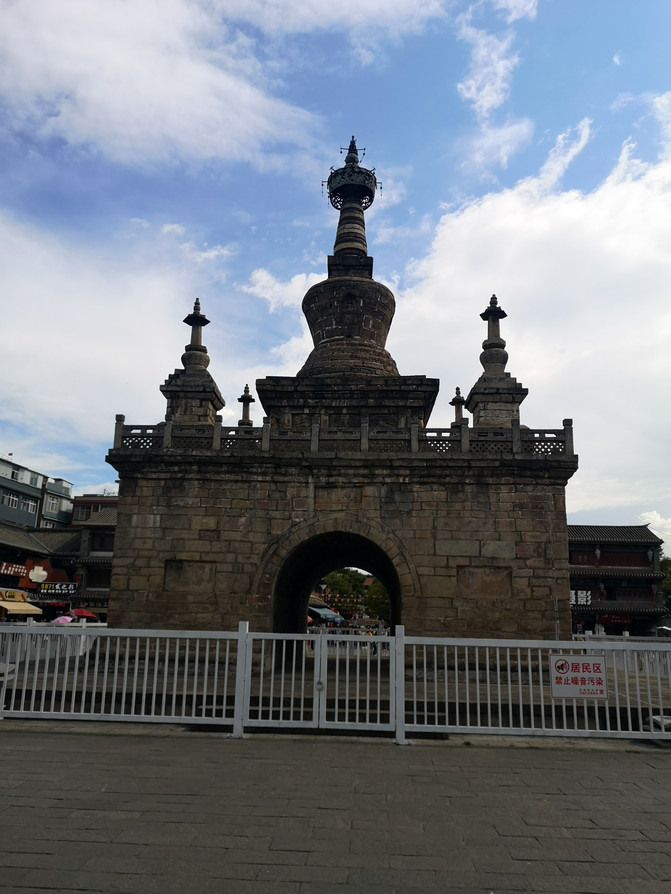
Guandu ancient town
After walking around the town and buying some Yunnan specialties such as flower cakes, we left.
It takes more than 40 minutes to take the airport bus from Kunming Railway Station to reach Kunming Airport, waiting at the airport to return to Tianjin to end the trip.
November 2019
Previous Article:Journey to Hunan in the rainy rain all the way south
